The first book devoted entirely to Mozart’s Requiem, by Albert Hahn, a small-town music director in northern Germany, describes the work in this way: ‘Now . . . we find ourselves in the beautiful morning light, led there by the inspired composer who through his passionate art banishes the loneliness of the barbaric night after long years of struggle.’1 Hahn’s account attributes to the Requiem a character that was common-place for much of the later nineteenth- and most of the twentieth-century as well. Abert, Saint-Foix, Bruno Walter and others describe the work as consoling, the pious, personal expression of a dying genius. For Eric Blom, the Requiem alternates ‘noble grandiloquence’ with ‘heart-searching supplication’ while Karl Geiringer described it as ‘a composition as transcendental as it is human . . . it leads us gently towards peace and salvation.’ Alfred Einstein wrote that, whoever composed the later parts of the work, ‘The total impression remains. Death is not a terrible vision but a friend.’2
These characterizations derive in part from Mozart’s famous letter to his father of 4 April 1787, barely a month before Leopold’s death:
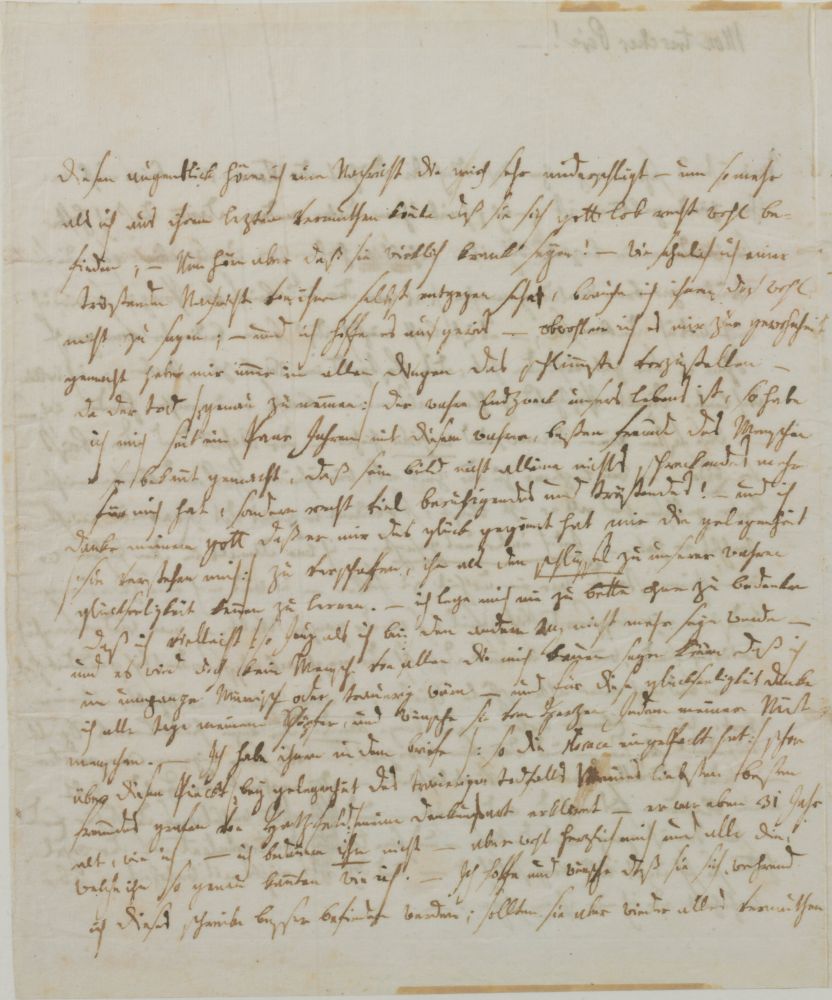
As death, when we come to consider it closely, is the true goal of our existence, I have formed during the last few years such close relations with this best and truest friend of mankind that his image is not only no longer terrifying to me, but is indeed very soothing and consoling.; And I thank my God for graciously granting me the opportunity . . . to learn that death is the key which unlocks the door to our true happiness. I never lie down at night without reflecting that–young as I am–I may not live to see another day.
This letter, reprinted in most Mozart biographies since 1828,3 is freighted with biographical implications: its nobility and faith is a reflection not only of Mozart’s profoundly-held beliefs, but also strengthens us to accept his own premature death with the courage and trust we believe the composer himself must have displayed – a courage and trust evident in the Requiem. But does it really reflect Mozart’s attitude toward death?
In November 1771 Mozart witnessed a hanging in Milan yet it elicited no particular reaction from him; on the contrary, he wrote to his sister: ‘I saw four scoundrels hanged in the cathedral square. They hang people here just as they do in Lyon.’ And when Leopold’s favorite poet, Christian Füchtegott Gellert, died in 1770, Mozart wrote to his sister: ‘I have nothing new except that Herr gelehrt [Herr learned, a pun on the name Gellert], the poet from Leipzig died, and since his death has composed no more poetry.’ Voltaire’s death prompted Mozart to write, ‘that godless arch-rascal Voltaire has pegged out [crepirt] like a dog, like a beast’ (letter of 3 July 1778) and when the court violinist Joseph Hafeneder died in 1784, Mozart was sorry chiefly because it would mean extra work for his father teaching the boys at the Salzburg chapel house (letter of 20 February 1784).
By the same token, early accounts of the Requiem say nothing about its consoling character. Ignaz Arnold, in his Mozarts Geist of 1803, noted the work’s ‘gloomy seriousness and dark melancholy’ while Christian Friedrich Schwenke looked in vain for the ‘pious humility of expression proper to such a solemn appeal to the mercy of the Redeemer.’ During the so-called Requiem-Streit of the 1820s, Gottfried Weber asserted that the ‘Confutatis’ could not be by Mozart because it ‘emphasizes, con amore, the egotistical baseness of the words and by the ferocious unison of the stringed instruments maliciously incites the Judge of the World to hurl the cursed crowd of sinners into the deepest abyss.’ Hans Georg Nägeli, in his Vorlesungen über Musik, objected to the many violent changes of key and arbitrary alternations of major and minor that turn the Kyrie fugue into a ‘barbarous confusion of sounds.’4
How is it, then, that the Requiem acquired its consoling character? And is there another way to read the work, one closer to Mozart’s late eighteenth century?
*
‘Someone should have painted [a picture of] the dying Mozart, the score of the Requiem in his hand’ wrote Nissen in his biography of 1828. In fact, they did, but only later. And what these pictures show is a transformation, not only in the representation of Mozart’s death, but in the meaning of the Requiem as well.
The earliest, a lithograph by Franz Schramm titled Ein Moment aus den letzten Tagen Mozart’s, probably dates from mid-century. It shows Mozart with the score of the Requiem open on his lap; his amanuensis Franz Xaver Süssmayr receives last minute instructions from the composer on how to complete the work; his wife, Constanze, prays at the foot of a crucifix in a room off to the side; and an unidentified stranger – no doubt the ‘grey messenger’ who brought the Requiem commission to Mozart in the first place – appears to be leaving through the main door. It is an intensely private scene, inhabited only by the composer, those closest to him and the spirit of death itself who, presumably having delivered his message, takes an unsympathetic leave.
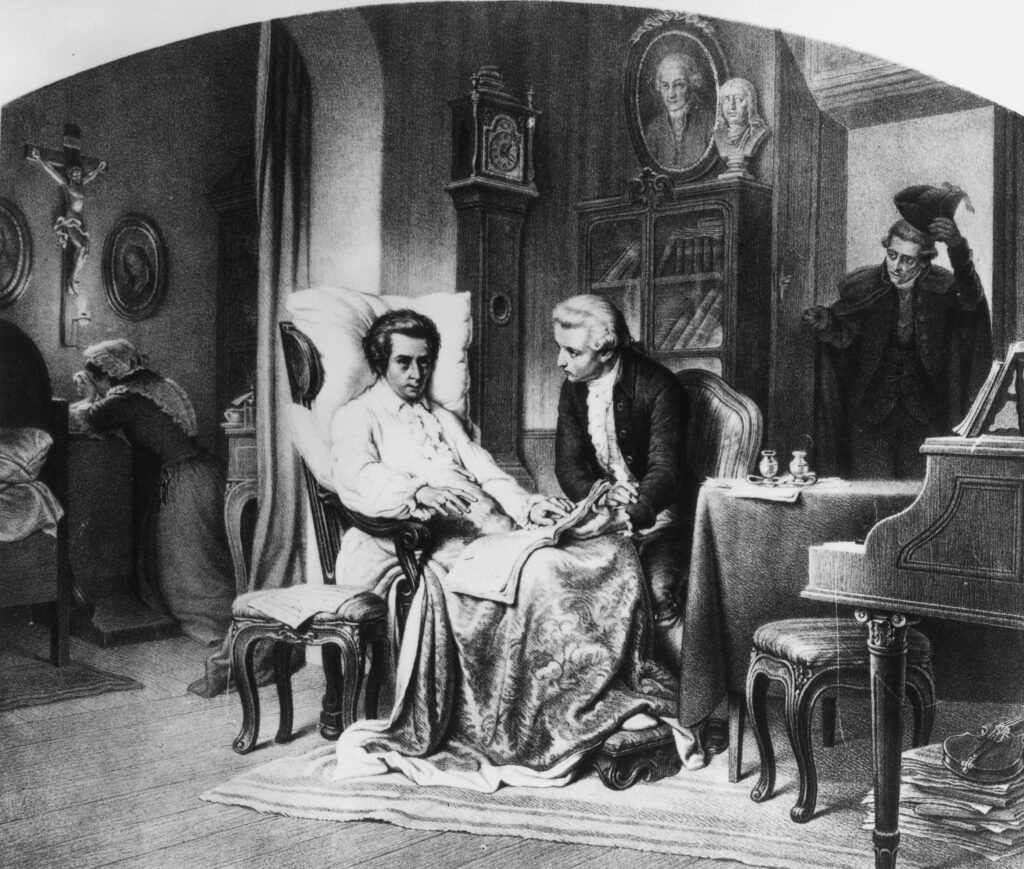
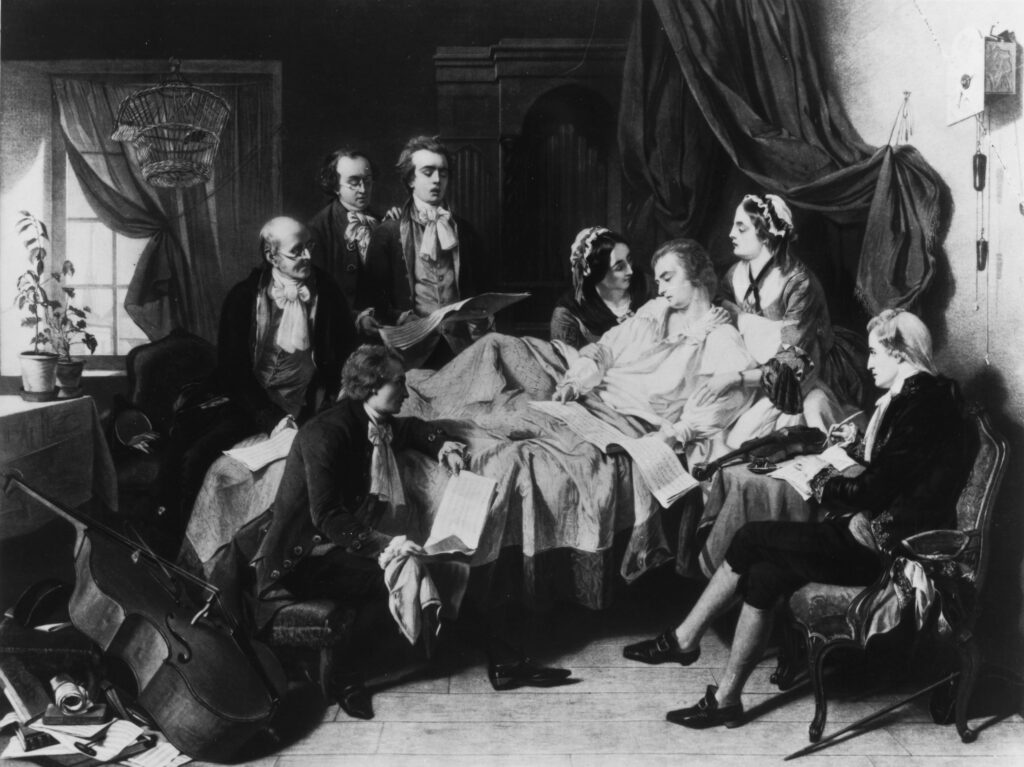
Henry Nelson O’Neill’s Mozart: The fulfillment of his strange presentiment about the Requiem from 1862, elaborates on this scene. Mozart once again has the Requiem on his lap; Constanze and Süssmayr are there too, as well as Sophie Haibel, Constanze’s sister. The ‘grey messenger’ has disappeared but four men read through the work for Mozart. A cello and a violin lie silent at the foot of the bed. This picture purports to represent a gathering at Mozart’s house on 4 December 1791, a gathering first reported in the 1827 obituary of Mozart’s friend Benedikt Schack, the first Tamino in Die Zauberflöte:
As soon as he had completed a number, he had it sung through, and played the instrumental accompaniment to it on his piano. On the very eve of his death, he had the score of the Requiem brought to his bed, and himself (it was two o’clock in the afternoon) sang the alto part; Schack, the family friend, sang the soprano line, as he had always previously done, Hofer, Mozart’s brother-in-law, took the tenor, Gerle, later bass singer at the Mannheim Theatre, the bass. They were at the first bars of the Lacrimosa when Mozart began to weep bitterly, laid the score on one side, and eleven hours later, at one o’clock in the morning . . . departed this life.5
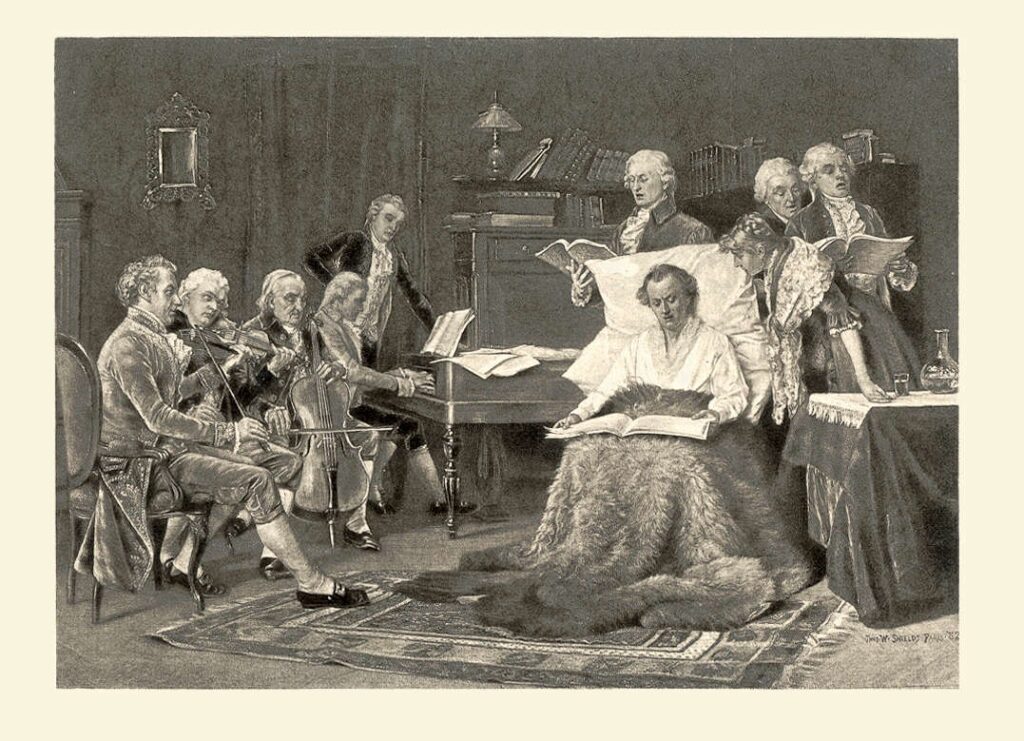
O’Neill’s painting is more active, more crowded than Schramm’s. And Thomas Shield’s lithograph of ca. 1880 is more crowded still: in addition to Mozart, Constanze and Süssmayr, the performance of the Requiem is now accompanied by a small orchestra and a keyboard players, in addition to the four singers. It is no longer a private performance and Mozart’s death is no longer a private death: both have gone public. It is, rather, the death of the artist.
Or at least this is what a final picture, an anonymous oil painting from the end of the century, shows. Here is the most remarkable transformation of all: not only does Mozart, still in his heavenly white night shirt as if a divine light shines on him – or perhaps in his burial dress, propped up in his coffin – conduct the work – he is a nineteenth-century director-artist, not an eighteenth-century participant-performer – but there are no singers. The Requiem has become a work of absolute music and the essence of the Romantic spirit.6
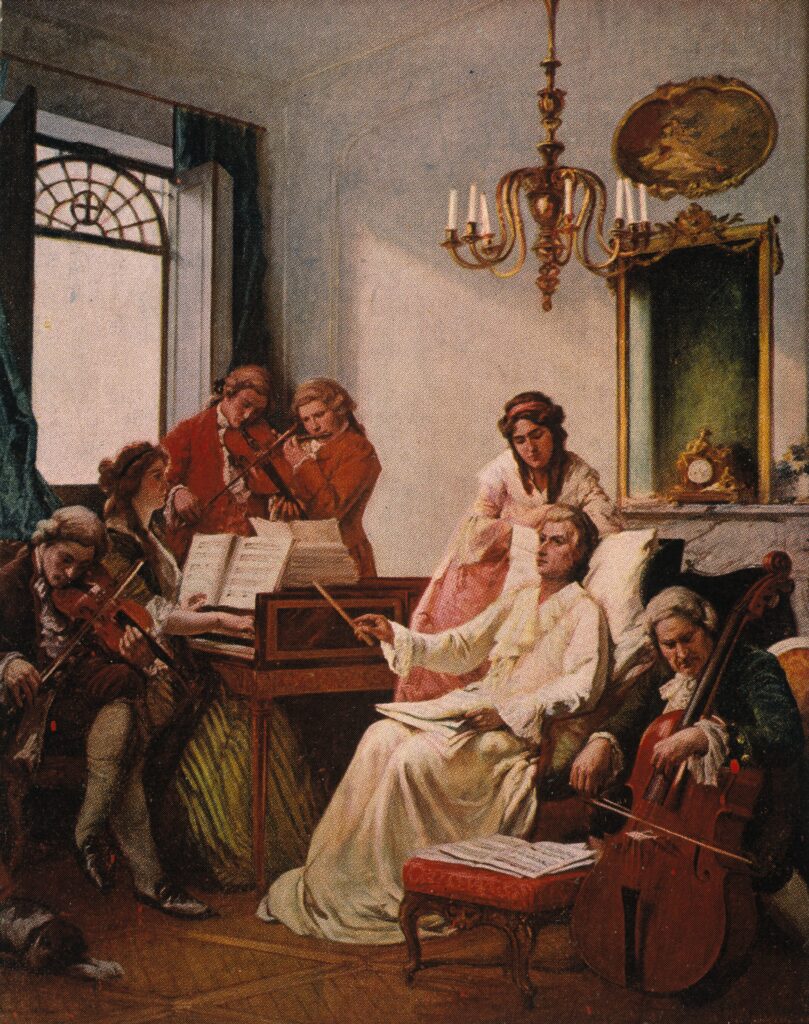
The pictorial transfiguration of Mozart’s death from the private to the public, and of the Requiem from sacred to secular absolute music, mirrors the performance history of the work. Almost from the beginning of the nineteenth century, the Requiem was performed by choral societies and in concert halls across Europe. It was given at Covent Garden in 1801, by students of the Paris Conservatoire in 1804, and in Frankfurt, Mannheim, Braunschweig, Leipzig and Frankfurt. A performance at Breslau was prefaced by two movements from Haydn’s Trauer symphony; in Berlin it was given with the overture to Gluck’s Alceste.7 This appropriation of the Requiem as secular did not go unchallenged. When it was given in German at Leipzig in the spring of 1801, an anonymous correspondent for the Allgemeine musikalische Zeitung wrote: ‘Connoisseurs will in any case prefer to hear this work with the original text, not only because Mozart here more than anywhere was bound by each individual word of the text–realizing the enormity of his vision, the darkness of his ideas, the authentically gothic ways in which they are combined–but also because it probably cannot be realized adequately in any barbaric modern tongue. . . We cannot put it any other way–it is transformed into a Protestant (or if you prefer, ‘enlightened’) parody.’8 More pithily, E. T. A. Hoffmann wrote: ‘The Requiem, performed in the concert hall, is not the same music: it is the appearance of a saint at a ball!’
But appropriated it was and not only by choral and philharmonic societies for public concerts. Before long, the Requiem came to represent the celebration of death in general, of both the great and the small: in Berlin it was given during a period of mourning for the Queen mother; at Leipzig it was played in honor of General Maçon, the Imperial French governor of the city; and a performance in Prague in 1801 to honor a local music patron, one Freyherr von Ledebour, made such an impression that ‘a few days later two citizens requested that it be performed at memorial services for their relatives.’9 More than that: the Requiem came to symbolize the death of greatness, the death of art, and the death of the human spirit. It was a musical centerpiece at the funerals of Heinrich von Collin, of Weber, Beethoven and, later, Napoleon.
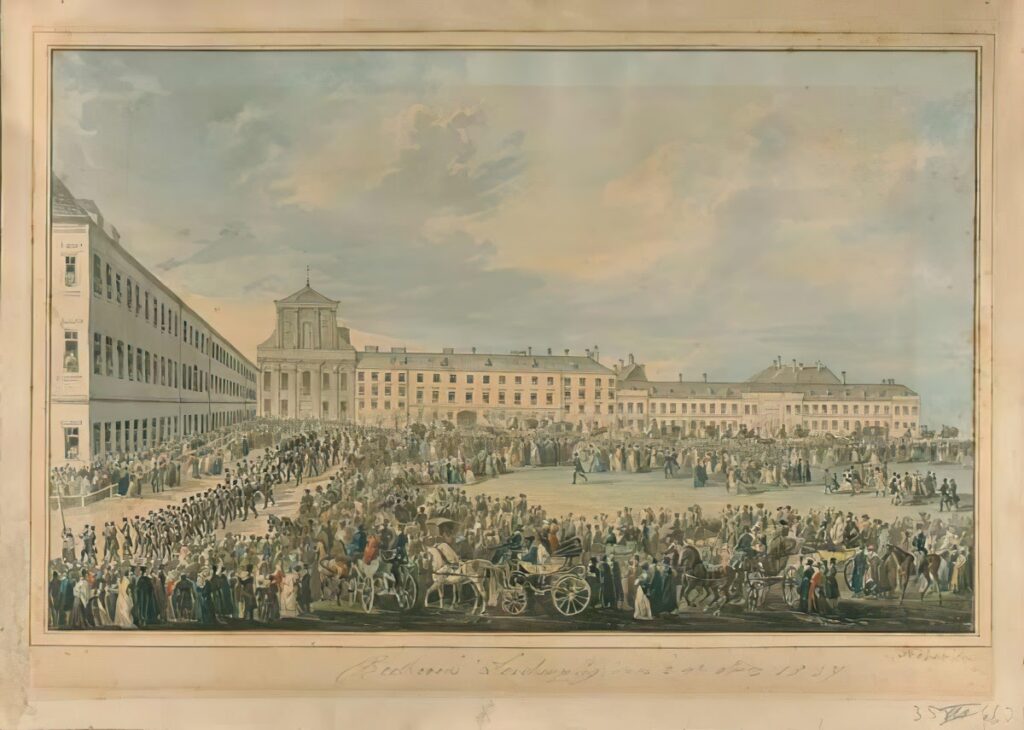
This celebration of death as a manifestation of the human spirit, as an event to be glorified for its profoundly human character, was a new idea. For much of the eighteenth century, death had been something to fear. One strain of thinking, best represented in Edward Young’s poem Night Thoughts of 1742, encouraged aspirations towards a ‘good’ death, one in which an appropriate, moral life is led and death foreseen and properly prepared for. Widely translated and admired, Young’s work was intended to serve as a ‘catalyst in the cultivation of hopes of eternal life’:10 Lessing regarded it as a masterpiece of the sublime while Goethe acknowledged its influence on his Die Leiden des jungen Werthers. A more virulent strain, however, saw death as horror. In his poem The Grave of 1743, Robert Blair wrote: ‘. . . The grave, dread thing! / Men shiver when thou’art named: Nature appall’d / Shakes off her wonted firmness. Ah! How dark / Thy long-extended realms, and rueful wastes! / Where nought but silence reigns, and night, dark night.
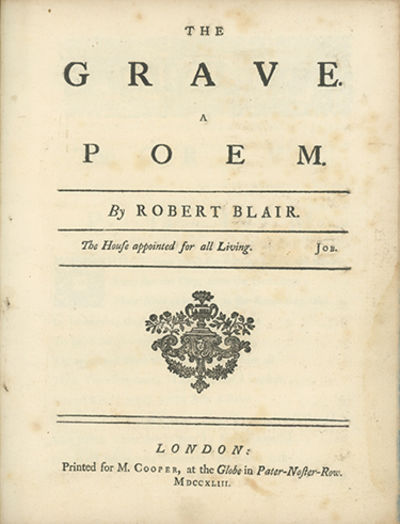
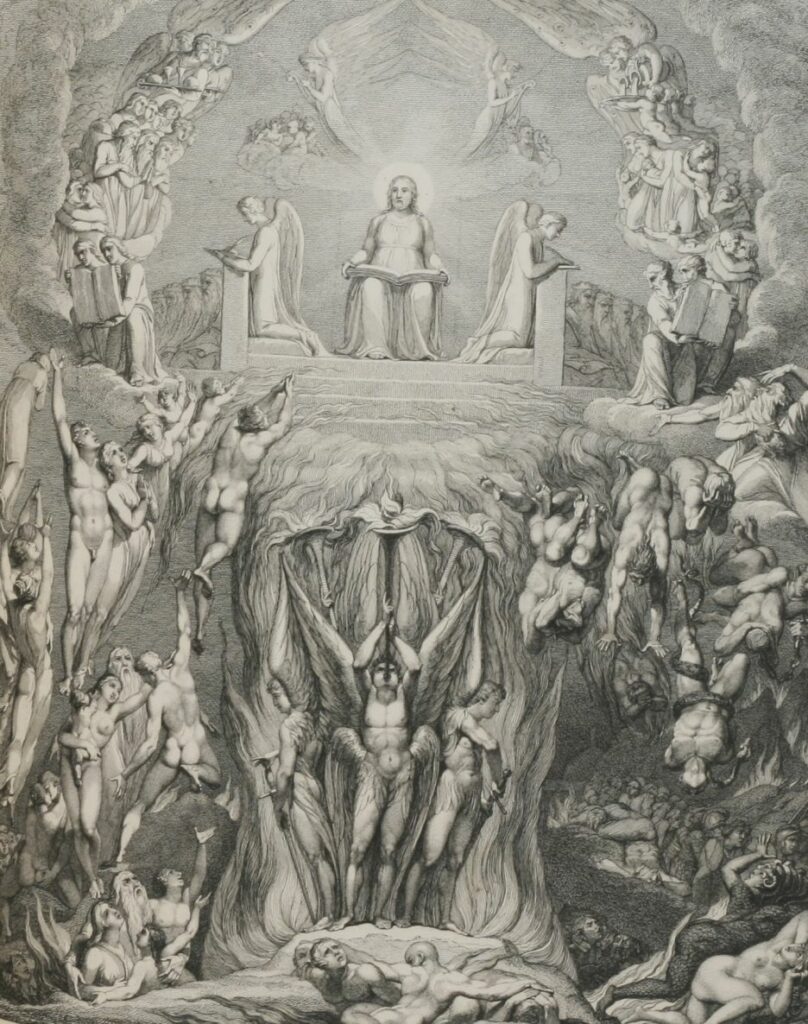
Blair’s gothic vision was equally potent, inspiring images of graveyards, solitary mourners, night scenes and ruined abbeys, even if it was short-lived. By the beginning of the nineteenth century, such horrific scenes were overtaken by images of Arcadian memorial gardens that sought to banish decay, decomposition and graveyards, a trend was already evident in the late eighteenth century: Cajus Lorenz Hirschfeld’s Theorie der Gartenkunst advocated, on English models, the introduction of memorials in the form of urns, columns and buildings in gardens. This was a reaction not only to earlier images, but to the unsanitary, malodorous, chaotic conditions of late eighteenth-century burial as well and it resulted in schemes such as René-Louis Marquis de Girardin’s Elysée for Jean-Jacques Rousseau at Eremonville, later a model for Henriette Caroline of Hesse-Darmstadt’s Herrengarten.
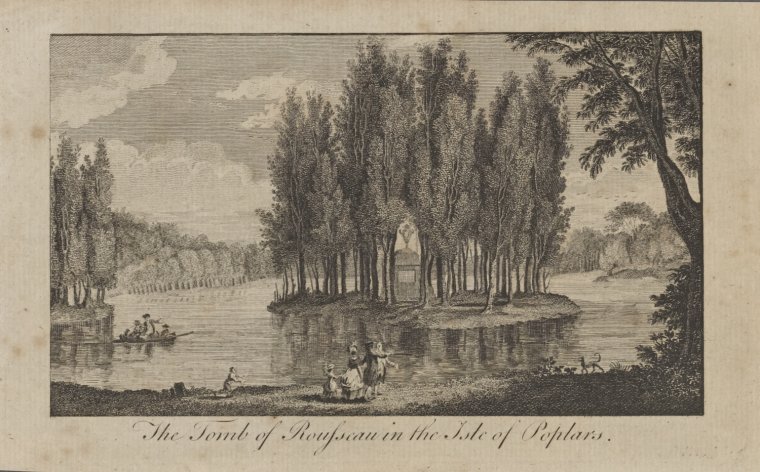
It was out of these memorial gardens, and the view that burial grounds could ‘become a means of social engineering, promoting reason and calm,’11 that the modern cemetery arose. An official decree of 12 June 1804 drew up rules for the construction of French cemeteries, prohibiting them in churchyards and towns, and ordering them to be built outside urban areas, planted with trees and shrubs. The cemetery – and death – was banished, distant from physical, everyday reality, a haven of peace and repose. Pere-Lachaise became the prototypical nineteenth-century funerary garden. (In Vienna, Joseph II instituted similar reforms as early as 1784, removing graveyards beyond the city limits, but these reforms grew out of economic and public health concerns, not philosophical or social-engineering ones. Paradoxically, one of his regulations served only to increase the sense of horror associated with death, abandoning the corpse to nature: ‘The only objective in burial is to promote decomposition as soon as possible, and there is no greater hindrance to this process than burial in coffins. Thus it is recommended for the present that bodies be sown unclothed [and buried] in linen sacks.’ This generated such a storm of protest that in 1785 Joseph issued a court circular rescinding the regulation: ‘[People] go to great lengths to ensure their bodies will decay slowly after death, and thus remain stinking carrion for as long as possible. So I no longer care how they want to be buried.’)12
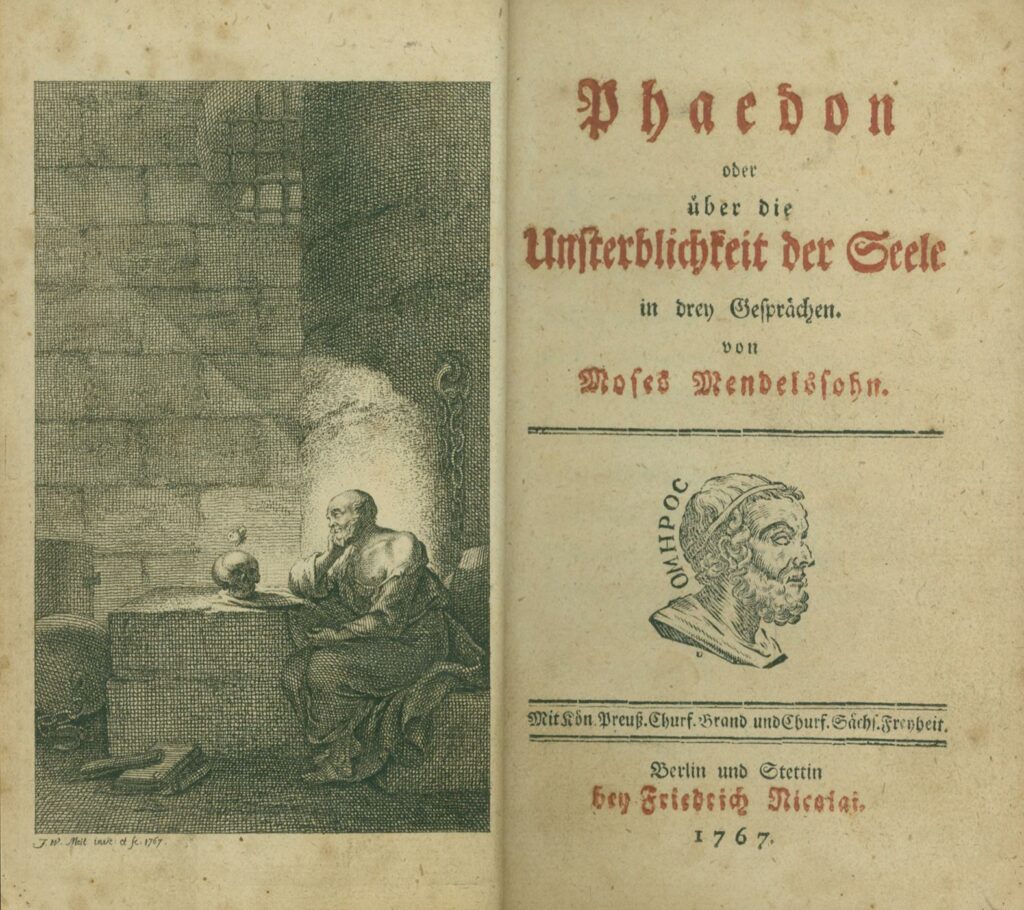
There is a broader context within which these concerns can be situated: the debate over the immortality of the soul. Moses Mendelssohn’s Phaedon, oder die Unsterblicheit der Seele of 1767, a vigorous defence of immortality, was widely read; Mozart even owned a copy.13 But this was not the only view. [Phaedon image] Arguments denying immortality had already asserted themselves in the seventeenth century. Thomas Hobbes argued that to believe in immortality was to forsake not only rational thought but Nature as well, while David Hume proposed that man’s fear was proof enough that death ends all: Nature would not imbue us with such horror unless there were something to fear.14
The French philosophes similarly rejected the idea of immortality. For them, death was an unpleasant natural accident and immortality a priestly lie that inhibited the achievement of a better life in the here and now. This was not to deny immortality altogether, or at least some form of immortality: Nicolas de Caritat, marquis de Condorcet, in his Outline of the Progress of the Human Mind, may have been the first to promote the idea that the prolongation of life, the achievement of immortality, was not a function of belief in religion but of belief in man and his capacity to extend natural, vital forces. Here, at least, is a point of contact with Kant, even if he rejects Condorcet’s notion of a similarity between the achievement of moral perfection and the processes of nature. In his Dreams of a Spirit-Seer, Kant asserted the existence of immaterial natures, including the soul, as well as his belief in moral perfectability through practical reasoning of moral experience. And in the Critique of Pure Reason he wrote that while virtue ought to produce happiness, this was not the case; instead, ‘virtue is attainable only if there is infinite progress, hence there must be another life.’ Since the achievement of the highest good is the necessary object of a moral will, this obligation must be capable of fulfillment – accordingly, the obligation itself already argues for immortality.15
In effect, Kant reinscribes wherein the immortality of the soul lies: in man, not in religion. And his argument was powerfully taken up by later philosophers and poets. Johann Gottlieb Fichte transformed Kant’s reasoning into an assertion of the primacy of the Ego: ‘Even my body may decay and become dust,’ he writes, ‘this body is not I. . . Long after the youngest among the millions of suns which shine over my head has sent forth its last rays of light, I shall still remain, unaltered and intact, the same as I am today.’16 This is absolute Ego, Hegel’s ‘World Spirit,’ a higher moral life that demands perfection and is therefore eternal. This ‘World-Spirit’ – seen by Novalis as a reservoir of untapped possibilities, the ‘elevating [of] the lower into the higher’ and by Friedrich Wilhelm Joseph Schelling as subject to an odyssey ‘which strives to return to itself’17 – rehabilitates both death and immortality as not only positive, but exclusively human. As such, death is glorified and celebrated: poets write of good deaths, city planners build garden cemeteries, philharmonic societies perform the Requiem in concert halls, and artists paint Mozart’s dying moments as a work of absolute music.
But this is to travel far into the nineteenth century, to a time when the Requiem, as a result of these various cultural forces – historical, artistic, literary,18 religious and philosophical – could appropriately be read as a work of consolation. And if this constellation, especially as it gave rise to interpretation, crystallized only about the middle of the century, then it may be that there is another cultural model – whether Mozart subscribed to it or not – that explains the early reception of the work as barbaric and terrifying, a model that locates the work in a late eighteenth and early nineteenth century where death was not necessarily the noble end and goal of the human spirit, but was something, as Blair described it, to be feared, at a time when immortality was being questioned. Even the Freemasons, their belief in eternity notwithstanding, paint a bleak picture of death. In his funeral oration for Mozart, Karl Friedrich Hensler wrote: ‘Decay! – I do not believe that human nature can conceive anything more terrifying, more awesome than this! Accustomed as we are to looking upon our body as a vital part of our being, unacquainted with the nature, the condition and the particular occupations of our mind divorced from it–and then the thought: soon this body will disintegrate into dust or, according to circumstance, become the habitat and food for vile insects. . . . Each day that we live, each hour that we number, night itself and sleep: all is either an image or a summons of Death for us.‘19
*
‘Et lux perpetua luceat eis’ (‘And grant them eternal light’) – surely a metaphor for immortality – becomes in Mozart’s setting of the Requiem a catalyst for confrontation, uncertainty, fear and decline. [The following discussion centers chiefly on the ‘Introit’ – see immediately below for a score that can be consulted in conjunction with this discussion, or that can be downloaded.] The text occurs three times in the Introit: first mediating between ‘Requiem aeternam’ and ‘Te decet hymnus’ (m. 15) and again at the end, twice in succession (from m. 43). But the third and last statement is remarkable: the text collapses in on itself, without the internal repetitions of the two previous occurrences; the basset horns and bassoons fall silent; the strings give up their aggressive unison gesture; and the voices fall in register, occupying only the lower parts of their ranges. A slow chromatic descent brings the movement to an inconclusive end.
This progression, frequently associated in the eighteenth century with death and mourning, may in this case be even more than an isolated sign of death, for it represents the final stage in a progressive deterioration over the course of the movement, a long-range rhetorical gesture that overwhelms both the local need to cadence and the generic convention of introducing a fugue with a slow, often open-ended, introduction. At its first occurrence, ‘et lux perpetua luceat eis,’ with its strong orchestral accoutrements, effects a stable and decisive cadence to B-flat major, moving the work away from its dark D minor opening to the relative calm of ‘Te decet hymnus.’ When it returns, however, light gives way to shade: the vocal texture is fractured, pitting the sopranos against the other parts, and major moves to minor and minor to diminished seventh before settling on the dominant of D minor. Resolution – or non-resolution – comes only with the final, dark chromatic descent, an inconclusive slipping away, a final degradation of the successive undermining of the sense of the text.20 What kind of eternal light is this, that fades so readily, that holds out a promise of redemption only to steal it back in the last moments? There is a similar death elsewhere in Mozart: the Commendatore in Don Giovanni. Summarily dispatched by the Don, the Commendatore does not die a ‘good death.’ And like the eternal light of the Requiem, life slips from his grasp, chromatically ebbing away, unresolved both musically and humanly. It is a violent, brutal death.
There is anger here, too. In describing Osmin’s towering rage in Die Entführung, Mozart write to his father:
The passage ‘Drum beim Barte des Propheten’ is indeed in the same tempo, but with quick notes. But as Osmin’s fury gradually increases, there comes–just when the aria seems to be at an end–the allegro assai, which is in a totally different meter and in a different key. This is bound to be very effective for just as a man in such a towering rage oversteps all the bounds of order, moderation and propriety and completely forgets himself, so must the music too forget itself. But as passions, whether violent or not, must never be expressed in such a way as to excite disgust, and as music, even in the most terrible situations, must never offend the ear . . . I have from F, the key in which the aria is written, not into a remote key, but into a related one, not however, into its nearest relative D minor, but into the more remote A minor.21
This is very nearly what the first statement of ‘Et lux perpetua luceat eis’ achieves: a modulation not to the nearest key – F major in a D minor movement – but to the more remote although still related B-flat major. As such, it not only subverts motion to the dominant but facilitates its bypassing altogether, generating a stark and wrenching return to the tonic (m. 34): where the text ‘Exaudi orationem meam / Ad te omnis caro veniet’ (‘Hear my prayer / All flesh shall come before Thee’) finally cadences to G minor, the basses enter on D with ‘Requiem aeternam,’ just as they had originally. There is no preparation here, only return – the sense of ‘eternal peace’ is undercut by a sudden death. Possibly no preparation was to be expected, even from the start: the opening orchestral passage similarly cadences away from the tonic (here to the dominant minor) only to be forced back to the home key by three shattering chords (mm. 6-8).
The restatement of the ‘Requiem’ text (m. 34), like Nägeli’s description of the Kyrie fugue, is a ‘confusion of sounds.’ Where the basses and tenors take up the Requiem theme, the altos and sopranos have a new countermelody, one not yet heard in the voices; previously it was given only in the orchestra, first as a transitional figure (m. 20) and then as accompaniment to the soprano solo at ‘Te decet hymnus’ (mm. 21-25). Presented this way, with the texts ‘Requiem aeternam’ and ‘Dona nobis pacem’ overlapping, what emerges is not a supplicating plea for eternal rest but an insistent demand: ‘Requiem’ and ‘dona’ are the only textual elements to emerge clearly in the setting. Who would make such a demand? Perhaps only the terror-struck, perhaps only those who can conceive of nothing beyond their impending deaths. For even at ‘Te decet hymnus’ (‘Thou shalt have praise in Zion, o God, and homage shall be paid to Thee in Jerusalem’), it is the sense of self and mortality that gains the upper hand. With the turn to G minor at measure 26, the focus of the text not only shifts to the individual (‘Ex audi orationem meam,’ ‘Hear my prayer’), but the solo soprano melody, centered on God and repeated by the choral sopranos, is aggressively overwhelmed by the other voices.
And by the orchestra. It too adds to the horror of the setting, suggesting not only the slow progress of a funeral cortege in the opening ritornello, but also by rhythmically and affectively destabilizing the first entry of the chorus. The entry is unstable enough as it is: as most commentary on the Requiem notes, the voices enter on weak beats, generating dissonant suspensions. But it is the violins that actualize a truly terrifying moment, with slashing, syncopated octaves leaping wildly through augmented fourths, diminished fifths and minor sevenths. Like virtually every other motive, these too return at the recapitulation. And having worked their terror and confusion, they eventually give way, as does the entire movement, to that final moment when life finally slips away.
It is not only the Introit that manifests the horror and uncertainly of death. The Kyrie double fugue is an unstoppable floodtide of sound with few if any points of repose, no lengthy interludes preparing the re-entry of the subject, and a succession of cadences that are either interrupted or quickly abandoned. As in the Introit, dominant tonalities are overshadowed by the darker world of the subdominant and the music grinds to a halt, just before the end. The ‘Dies Irae’ is littered with syncopations and tremolandos, the violins often duplicating the slashing effect of the first movement, as well as an abrupt modulation from A minor to C minor. In the ‘Confutatis’, no-one takes heed of the prayers of the women to be spared the fires of Hell: like ‘Salva me’ in the ‘Rex tremendae’, they are weak and pathetic. Unable to sustain a major tonality, and joined with the crowd at ‘Oro supplex et acclinis’ (‘Bowed down in supplication I beg thee’), they cannot prevent a final, catastrophic slide into their ‘last hour’ (beginning at m. 25), enharmonically descending from A minor through A-flat minor, G minor and G-flat/F-sharp minor. Perpetual light does not shine here, either, and whatever inconclusive repose may come from the unconventionally prepared arrival at F major is immediately undercut by the resurgence of D minor and the ‘Lacrimosa’.
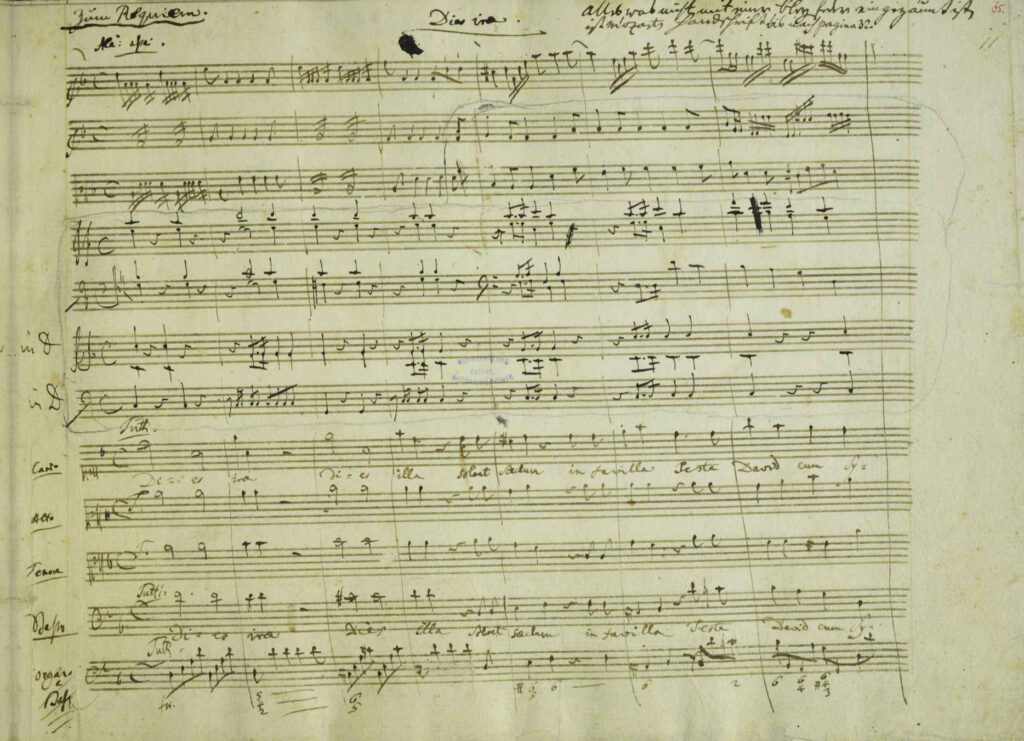
In the ‘Tuba mirum’, a mode shift at ‘Mors stupebit et natura’ (‘Death and nature shall be stunned’) announces the rendering of accounts, the orchestral basses revert to their cortege figure at ‘unde mundus judicetur’ (‘whereby the world will be judged,’ mm. 34–36), and the movement ends not with affirmation but with a question frightening in its implications: ‘Quem patronem rogaturus cum vix justus sit sicurus?’ (‘To which protector shall I appeal when even the just man is barely safe?’). The setting off of this line as a point of specific reflection – it is repeated three times (like ‘Et lux perpetua’) more than any other element of the text which Mozart hastens through, virtually without repetition, to his arrival at the fateful question – is intentional: at this juncture, the division of the Sequence text is determined by the composer.
Even the ‘Recordare’, usually described as manifesting comfort and trust, is undermined in Mozart’s setting. The dissonant suspension at the initial entry of the second voice, reminiscent of the dissonant suspensions of the Introit, is possibly not a sign of Mozart’s ‘interiority’, as Abert characterized it, but a portent of worse to come: the phrase following the main theme takes over motifs familiar from the terror-laden earlier movements, in particular ‘Quantus tremor et futures’ (‘What trembling there shall be when the judge shall come to weigh everything strictly’). There is a breathlessness at the episode ‘Qaerens me’ (‘Seeking me’), a shift in mode, and short phrases where the soloists ‘steal’ the words from each others’ mouths, moving abruptly from C minor to D minor (beginning at m. 38). The return of the main theme at m. 54 comes in the darker key of B-flat major and at ‘Ingemisco, tamquam reus’ (‘I groan, like the sinner that I am’) the gentle accompanying figure heard earlier in the movement disappears: the funeral cortege returns in the orchestra together with sudden changes of register and the text screws itself up from B-flat major to C minor and then D minor.
To the very last, in the ‘Domine Jesu Christe,’ Mozart’s setting undermines faith and confronts fear, manipulating or contradicting the text and recalling motives and gestures that in earlier movements reflect the anxieties of the still-living. Notated in Mozart’s autograph fragment only for the voices and basso continuo, the movement lacks any indication of orchestral involvement with one exception: the fugue at ‘Quam olim Abrahae’ where suddenly, and without warning, the violins have a leaping, slashing, sometimes off-beat figure, not unlike the violin part in the ‘Introit’. After pages of empty staves for the strings and winds – of nothing that absolutely had to be said in the orchestra to this point – the figure leaps off the page and into the ear. The setting of the fugue itself is also reminiscent of the Introit, where ‘Dona’ and ‘Requiem’ collide: here it is the breathlessness, the relative lack of episodes and derivation of the whole from a single theme; the truncation of the initial soprano entry to omit ‘et semini ejus’ (‘and his seed’), focusses on the individual rather than the collective (even when the sopranos have an extended presentation of ‘et semini ejus’ (beginning at m. 67), while the incessant repetition of the opening text with metric stresses and its phrase shape emphasize ‘promisisti’ – not ‘Let the holy standard-bearer Michael lead them into the holy light, as Thou dist promise Abraham and his seed’ but ‘You promised!’, not ‘Lord, grant them eternal rest, and let perpetual light shine upon them’ but ‘Grant them peace!’ (again, not unlike ‘Requiem’ and ‘dona’ in the ‘Introit). It is, Abert says, ‘a psychologically subtle portrait of the universal sense of agitation caused by the uncertain fate of the dead.’22
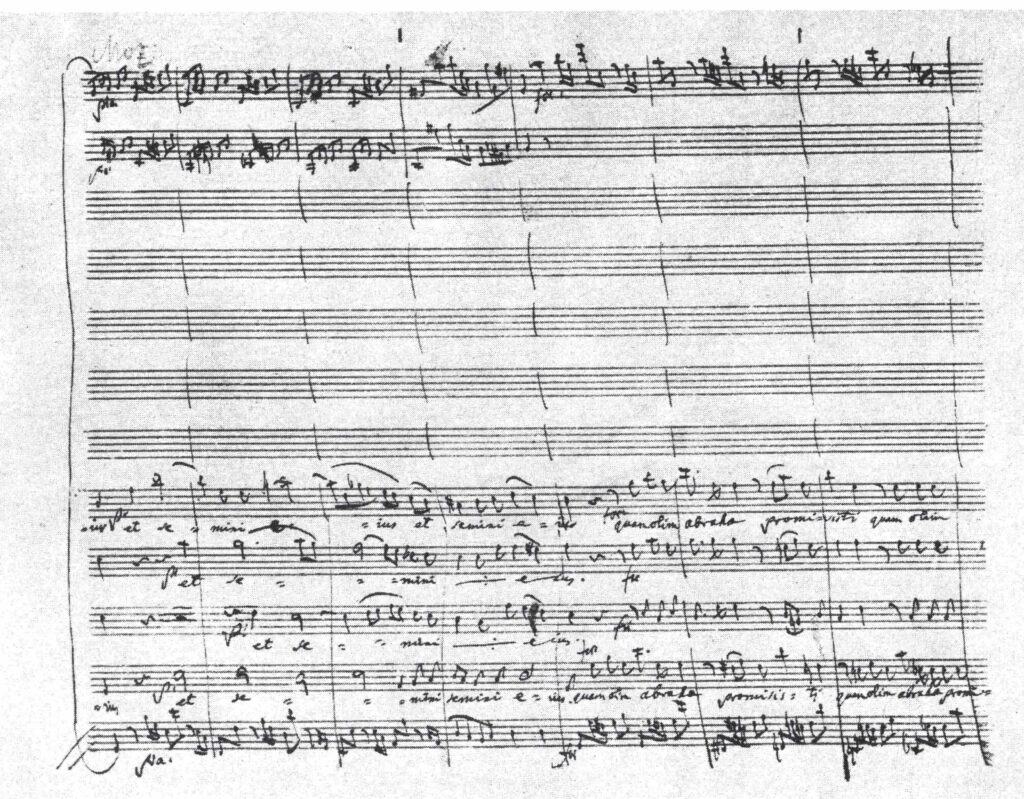
The ‘gentle death’ of Romanticism was not exclusive to the nineteenth century.23 Ludwig Hölty’s Der Tod of 1772 describes death as a ‘messenger of peace who opens paradise,’ while Samuel Taylor Coleridge, in his ‘Epitaph on an Infant,’ writes: ‘Ere Sin could blight or Sorrow fade, Death came with friendly care: / The opening Bud to Heaven convey’d / And bade it blossom there.’24 Nor are readings of the Requiem as a work of consolation exclusive to the period after 1850. As early as 1802, an anonymous poet, having heard a performance at the Thomasschule in Leipzig, wrote: ‘Lamm Gottes, gieb dem Todten we’gen Frieden! / Da schwebt der Geist herab auf heil’gen Tönen’ (‘Lamb of God, give the dead eternal peace! / There the spirits sway to the heavenly tones’).25 Weber’s assertion that the Confutatis could not be by Mozart because it ‘maliciously incites the Judge of the World to hurl the cursed crowd of sinners into the abyss’ already suggests what he thought a Requiem setting ought to be. But the institutionalization of the Requiem as consolatory was almost inevitable, given the confluence of the Romantic celebration of death with increasingly calcified biographical accounts of Mozart’s final years. Almost by necessity, the composer’s very last works came – like death – to represent a rare human achievement.
From the very start, what was thought to be Mozart’s biography played a determining role in establishing a critical framework for readings of his works. And the Requiem was the lynch-pin composition, the catalyst for a teleology that by mid-century had elevated the composer to a prominent position in accounts of musical periods and musical styles. When it was first published in 1800, Breitkopf & Härtel advertised the Requiem as ‘Mozart’s last and most perfect work.’26 But on what basis was this critical judgement (admittedly advertising hype) made and the work sold? Not the piece itself, which to all intents and purposes remained unknown during the 1790s. Barely a handful of performances are recorded27 and very few copies, it seems, were ever made: Constanze had one for her performances in 1793 and 1796, one was given to Count Walsegg, who had commissioned the work, one to the Elector of Saxony and copies were sold to the King of Prussia and to Breitkopf & Härtel, while Süssmayr reportedly owned two. The music itself had virtually no public profile, either in Vienna or elsewhere.
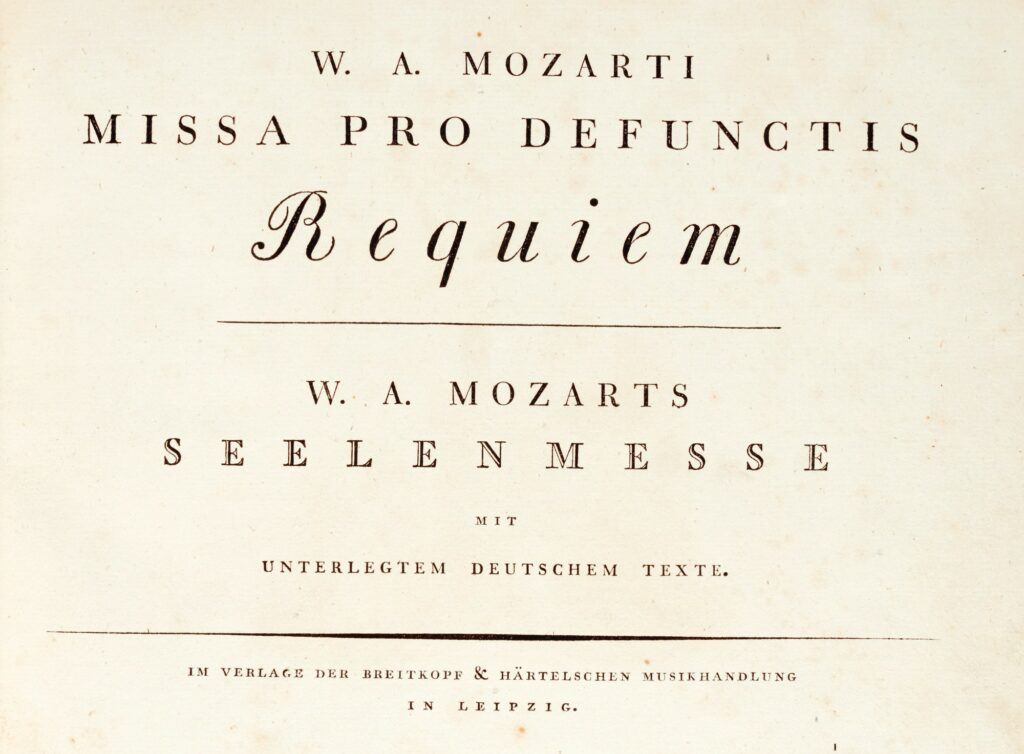
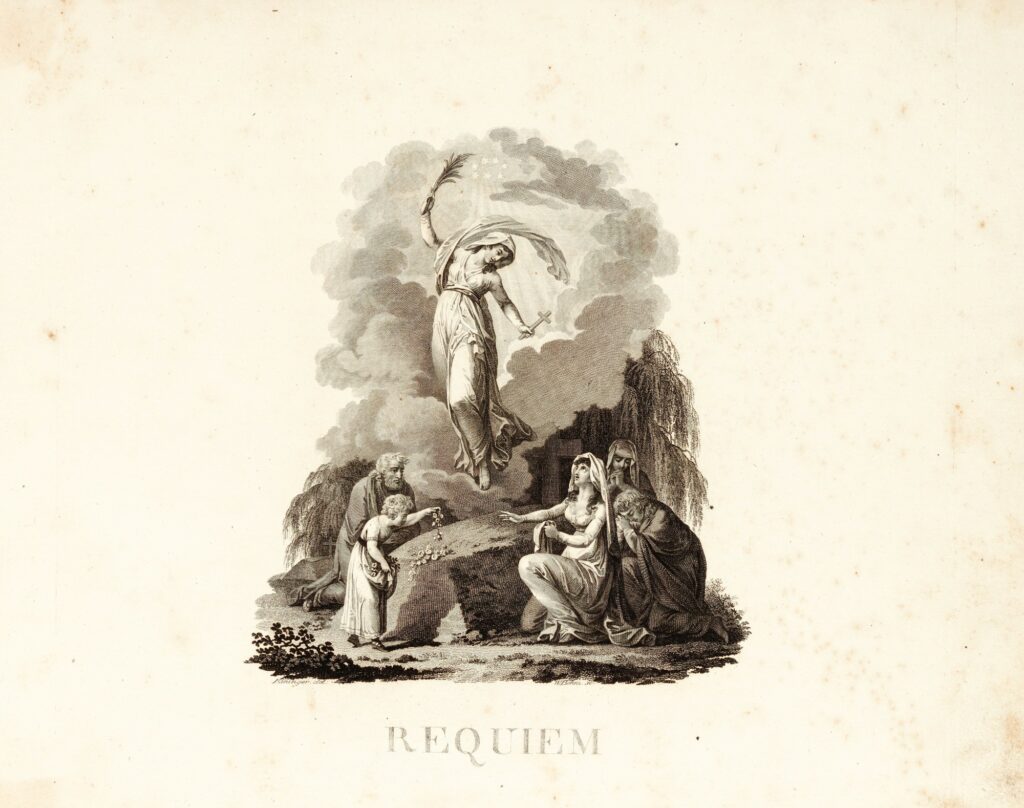
What was known, however, was Mozart’s tragic life story and in particular the story of the Requiem. The tale of its commission by an unknown stranger, and Mozart’s belief that he was writing it for himself, began circulating within weeks of his death in December 1791:
Some months before his death he received an unsigned letter, asking him to write a Requiem and to ask for it what he wanted. Because this work did not at all appeal to him, he thought, I will ask for so much that the patron will certainly leave me alone. A servant came the next day for his answer — Mozart wrote to the unknown patron that he could not write it for less than 60 ducats and then not before 2 or 3 months. The servant returned immediately with 30 ducats and said he would ask again in 3 months and if the mass were ready he would immediately hand over the other half of the money. So Mozart had to write it, which he did, often with tears in his eyes, constantly saying: I fear that I am writing a Requiem for myself.28
The power of this story was overwhelming and the importance of the Requiem – an importance that demanded it be read and heard biographically – secured. So much so, in fact, that as early as the first decade of the nineteenth century, when the work was performed and published, it was sometimes prefaced by an account of Mozart’s life: both the program booklet for the 1801 Covent Garden concert and the edition published by the Paris Conservatoire in 1804 include biographies of the composer. At the time, attaching a life story to a print was rare, perhaps even unique, for eighteenth-century music.
It was a common biographical trope of the nineteenth century to see Mozart’s final works as one last rousing of the composer’s spirit, a final, virtuous triumph after years of physical, economic and artistic decline.29 Ludwig Nohl describes Mozart’s mind as soaring ‘into regions beyond this life, where compensation for its inequalities would be found. . . The golden light of consolation tinged all his work. . . . A spirit of wonderful sweetness and reconciliation henceforth animates all his music.’30 Even more specifically, Abert identifies and universalizes Mozart’s final transcendence in the two works that came to represent the composer’s lasting legacy to mankind, Die Zauberflöte and the Requiem:
Even as a boy he had felt powerfully drawn to mysticism, and this tendency now emerged with increasing clarity during the last five years of his life, with the idea of death and the afterlife preoccupying his thoughts to a much greater extent than before, as the once hedonistic composer became increasingly conscious of the existence of a metaphysical world whose terrors he had first felt in Don Giovanni, before revealing its purifying and elevating force to him in Die Zauberflöte, a work that proclaims this force as the highest goal of human aspirations, while the Requiem addresses it from its metaphysical aspect as a power which, remote from all temporal concerns, arouses man’s feelings of guilt and need for redemption.31
Here is Novalis’s ‘romanticizing principle’ at its most extreme: the ‘lower’ – Mozart’s alleged sorry life, neglect, poverty and premature death – is elevated through his works to a ‘higher order.’ Unlike Mozart’s earthly remains, the Requiem could not, then, be buried and lost without a trace: it not only consoles us in the face death, it consoles us for the death of its author as well. Yet the work itself, at least in the early nineteenth century, seemed not to offer such solace. Instead, like the debates over immortality that swirl around its time and place, it was thought to manifest terror, anger and fear. In this sense, the Requiem is a fitting pendant to Hobbes’s reported declaration on his deathbed: ‘I am about to take my last voyage, a great leap in the dark.’
FOOTNOTES
1 Albert Hahn, Mozart’s Requiem. Zu besseren Verständnis bei Aufführungen mit einer neuen Uebersetzung, nebst einer Nachtrage und den Resultaten eines Vergleiches der Breitkopf und Härtelschen Partitur mit den Original- Manuscript der k. k. Hofbibliothek zu Wien (Bielfeld, 1867), 62.
2 Hermann Abert, W. A. Mozart (Leipzig, 1919–23), ii.700–29; Georges de Saint-Foix, W.-A. Mozart. Sa vie musicale et son oeuvre. V: les dernières années (Paris, 1946), 281–301; Bruno Walter, Theme and Variations (New York, 1946), 32; Eric Blom, Mozart (London, 1974), 181; Karl Geiringer, ‘The Church Music’, in H. C. Robbins Landon and Donald Mitchell (eds.), The Mozart Companion (London, 1956), 375; Alfred Einstein, Mozart: His Character, His Work, trans. Arthur Mendel and Nathan Broder (New York, 1945), 369.
3 It first appeared in Georg Nikolaus Nissen, Biographie W. A. Mozarts (Leipzig, 1828), 524–5.
4 Ignaz Arnold, Mozarts Geist (Erfurt, 1803), 418. For Schwenke, see the Allgemeine musikalische Zeitung 4 (1801–2), 8; Otto Jahn, Life of Mozart, trans. Pauline D. Townsend (London, 1891), iii.373; Hans Georg Nägeli, Vorlesungen über Musik (Stuttgart, 1826), 99.
5 Otto Erich Deutsch, Mozart. A Documentary Biography (second edition: London, 1966), 536-537.
6 Though treated only briefly treated here, these pictures of Mozart can also be interpreted in the context of nineteenth-century ‘death’ art more generally. See, for example, Philippe Ariès, L’homme devant la mort (Paris, 1977) or, specifically concerning Napoleon, Suzanne Lindsay, ‘Mummies and Tombs: Turenne, Napoléon, and Death Ritual’, The Art Bulletin, 82 (2005), 476–502. The importance of nineteenth-century ‘death’ art also extends to the early days of photography; see Le Dernier Portrait. Musée d’Orsay, Paris, 5 mar-26 mai 2002 [exhibition catalogue] (Paris, 2002). Also see Daniel K. L. Chua, Absolute Music and the Construction of Meaning (Cambridge, 1999). Of course, the Requiem was not the only sacred work or text to be secularized in the nineteenth century, as the examples of Beethoven’s Missa solemnis or Verdi’s Requiem show.
7 For the Covent Garden performance, see [J. Ashley], The Requiem . . . as performed under the direction of Mr. Ashley at the Theatre Royal, Covent Garden, during Lent 1801 (London, 1801). For performances elsewhere, see Allgemeine musikalische Zeitung 6 (1803–4), 507; 7 (1804–5), 429; and 11 (1808–9), 624. Further, see Thomas Bauman, ‘Requiem, but no Piece’, 19th Century Music 15 (1991), 151–61 and esp. 157.
8 Allgemeine musikalische Zeitung 3 (1800–01), 478.
9 Allgemeine musikalische Zeitung 3 (1800–01), 466.
10 John S. Curl, The Victorian Celebration of Death (Phoenix Mill, Gloucestershire, 2000), 7. The earliest German translation, by Johann Arnold Ebert, was published in 1751–2; further editions appeared in 1753 and 1756, as well as a different translation, by C. B. Kayser, in 1752. Also see Annette Richards, The Free Fantasia and the Musical Picturesque (Cambridge, 2001) and Matthew Head, ‘Music with “No Past”? Archaeologies of Joseph Haydn and The Creation’, 19th Century Music 23 (2000), pp. 191–217.
11 Curl, The Victorian Celebration of Death, 24.
12 See Volkmar Braunbehrens, Mozart in Vienna 1781–1791, trans. Timothy Bell (New York, 1990), 415–16. Joseph II’s burial reforms are also discussed in Johann Pezzl’s contemporaneous Skizze von Wien (Vienna, 1786–1790); see H. C. Robbins Landon, Mozart and Vienna (New York, 1991), 122–3. Concerning the historical development of cemeteries in general, see Philippe Ariès, The Hour of Our Death, trans. H. Weaver (New York, 1982), 491–556, and Richard A. Etlin, The Architecture of Death: The Transformation of the Cemetery in Eighteenth- Century France (Cambridge, MA, 1984).
13 Otto Erich Deutsch, Mozart. A Documentary Biography, 602. In fact, Mozart’s letter to his father of 7 April 1787 paraphrases Mendelssohn.
14 In particular, see ‘Of the Immortality of the Soul’, in David Hume, The Philosophical Works, ed. T. H. Green and T. H. Grose (London, 1882), vol. 4, pp. 399–406.
15 Condorcet, Esquisse d’un Tableau Historique des Progre`s de l’Esprit Humain (Paris, 1795), 358–63; Felix Gross (ed.), Kant’s Sämmtliche Werke (Leipzig, 1921), i.106; Jacques Choron, Death and Western Thought (New York, 1963), 145.
16 Johann Gottlieb Fichte, ‘Appelation an das Publicum’ (1799), in Hans Lindau (ed.), Schriften zu Fichte’s Atheismus-Streit (Munich, 1912), 149.
17 For a concise account of Hegel’s, Novalis’s and Schelling’s arguments, see Choron, Death and Western Thought, 154–8.
18 Further concerning literary representations of death, see Thomas Anz, ‘Der schöne und der häßliche Tod. Klassische und moderne Normen literarischer Diskurse über den Tod’, in K. Richter and J. Schönert (eds.), Klassik und Moderne. Die Weimarer Klassik as historisches Ereignis und Herausforderung im kulturgeschichtlichen Prozeß. Walter Müller-Seidel zum 65. Geburtstag (Stuttgart, 1983), 407–32.
19 Deutsch, Mozart. A Documentary Biography, 448–9.
20 The fact that the text occurs twice in succession at the end of the movement, and three times altogether, successively weakened and destabilized, is already an unusual compositional choice; normally it occurs only twice in settings of the Introit. Compare, for example, Michael Haydn’s Requiem of 1771 (Budapest: Edition Musica, 1979, edited O. Nagy), which is often cited as one of Mozart’s models.
21 Letter of 26 September 1781.
22 Abert, W. A. Mozart, 720.
23 See Karl S. Guthke, The Gender of Death: A Cultural History in Art and Literature (Cambridge, 1999), esp. 128–72.
24 Also see Ludwig Hölty, Sämtliche Werke, ed. W. Michel (Weimar, 1914), i.80, and E. Hartley Coleridge, The Complete Poetical Works of Samuel Taylor Coleridge (Oxford, 1912), i.68. On the other hand, even when Herder describes a ‘beautiful’ death in 1774, he betrays the common view of death as fearful: ‘When our poets tell us, again and again, that the death struggle is a matter of agony, of eyes growing dim, of death rattles, stares, horror and trembling, fear and the flames of hell, they misuse both imagination and language’ See B. Suphan (ed.), Herder. Sämmtliche Werke (Berlin, 1877–1913), v.656.
25 Allgemeine musikalische Zeitung 4 (1801-2), 336.
26 Allgemeine musikalische Zeitung, Intelligenz-Blatt No. XIX, 1 (September, 1799), n.p.
27 These include performances by Constanze in Vienna on 2 January 1793 and by Walsegg on 14 December 1793 as well as Constanze’s concert version give at Leipzig on 20 April 1796. Parts of the Requiem may have been given in Vienna as early as 10 December 1791; see Walther Brauneis, ‘Exequiem für Mozart’, Singende Kirche 37 (1991), 8–11 and idem, ‘Unveröffentlichte Nachrichten zum Dezember 1791 aus einer wiener Lokalzeitung’, in Mitteilungen der Internationalen Stiftung Mozarteum 1991, 165–8. A pre-1796 Leipzig performance was also given by J. A. Hiller; see Wolff, Mozart’s Requiem (Berkeley, 1994), 15, n. 49, and 27, n. 78–9.
28 See Ernst Hintermaier, ‘Eine frühe Requiem-Anekdote in einer Salzburger Zeitung’, Österreichische Musikzeitschrift 26 (1971), 436–7.
29 The persistence of this trope is evident, for example, in the title to the final chapter of Alec Hyatt King’s Mozart (London, 1970): ‘From Despair to the Triumph of the Spirit’.
30 Ludwig Nohl, Life of Mozart, trans. John J. Lalor (Chicago, 1880), 206–7.
31 Abert, W. A. Mozart, 705.


